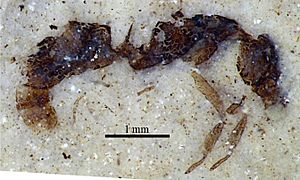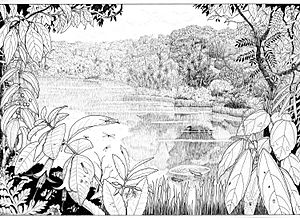Foulden Maar facts for kids
Quick facts for kids Foulden Maar |
|
|---|---|

Foulden Maar pit as seen from Moonlight Road
|
|
| Location | Otago, New Zealand |
| Coordinates | 45°31′36″S 170°13′06″E / 45.5268°S 170.2184°E |
| Volcanic field | Waipiata |
Foulden Maar is a special place in Otago, New Zealand. It's a fossil site near Middlemarch. About 23 million years ago, a volcano erupted here. This created a big crater that filled with water, forming a lake. Over time, this lake filled with a material called diatomite. Diatomite is made of tiny, hard shells from ancient algae called diatoms. This site has amazing fossils of plants, fish, spiders, and insects. These fossils come from a warm, wet forest that was here long ago. Foulden Maar is the only known site of its kind in the Southern Hemisphere. It is one of New Zealand's most important fossil sites.
Contents
What's in a Name?
Foulden Maar gets its name from a nearby farm called Foulden Hills. The farm was probably named after a town called Foulden in Scotland. Many other places nearby also have Scottish names. These include Kelso, Ettrick, Roxburgh, and Nenthorn.
How Foulden Maar Formed
Foulden Maar is a type of volcano called a maar-diatreme volcano. It is found in the Strath Taieri area, southeast of Middlemarch. Its crater was made about 23 million years ago. This happened during a special kind of volcanic eruption. The crater is now filled with fossilised diatomite. It also contains other rocks like sedimentary rock and pyroclastic rocks. Foulden Maar is part of the Waipiata Volcanic Field. This area shows where ancient volcanoes once erupted.
The Amazing Geology of Foulden Maar
The Foulden Maar crater is about 1,000 metres (3,300 feet) wide. The layer of diatomite inside it is thought to be 200 metres (660 feet) deep. The lake at Foulden Maar formed in a volcanic crater. This happened around 23 million years ago. The bottom of the lake was very deep and had no oxygen. This helped to preserve plants and animals that died there.
The lake was also cut off from rivers and streams. This meant that no water currents disturbed the layers of sediment. These thin layers are called diatomite. They are mostly made of one type of diatom called Encyonema jordaniforme. These tiny algae grew on rocks or plants in the lake. As the lake slowly filled up and dried out, the diatomite layers formed. They created a detailed fossil record that covers about 130,000 years.
Discovering Ancient Life: Palaeontology
Foulden Maar is one of New Zealand's most important fossil sites. It is special because it covers a time period not found anywhere else in the Southern Hemisphere. Gold miners first found fossils here in the early 1870s. Geologists Frederick Hutton and George Ulrich described them in 1875. They called the material "polishing powder."
Scientists have only dug in a small area, about the size of a tennis court. But they have already found hundreds of new species. The layers of sediment are full of fossil flowers, fruits, seeds, pollen, and bark from plants. They have also found fungi. Several new plant species have been discovered. A fossil plant group called Fouldenia is named after Foulden Maar.
Fossils of freshwater fish are very common here. The oldest known fossil of a galaxiid fish was found at Foulden Maar. This is the group that includes whitebait. The oldest known fossilised eel also comes from this site. Many arthropod fossils have been found too. These include spiders, stoneflies, dragonflies, termites, true bugs, true flies, beetles, caddis flies, and wasps, ants, and bees. The four spider fossils found are the first ones ever identified in New Zealand. The first fossil hymenopteran (like an ant) in New Zealand was also found here.
What the Fossils Tell Us: Palaeoecology
The fossils, especially pollen and spores, show that the area was a warm, wet forest. It had tall canopy trees and smaller shrubs and ferns below. The climate was similar to modern-day southeastern Queensland, Australia. Some plant species found here no longer grow in New Zealand. The lake had small and large galaxiid fish and eels. Ducks likely lived there too, based on fossil droppings. It's also possible that crocodiles lived in the lake.
Scientists have used fossil leaves from Foulden Maar. They help to connect past increases in carbon dioxide levels with the melting of Antarctic ice. The thin layers of diatomite have also been studied. They reveal details about New Zealand's climate from that ancient time.
Mining at Foulden Maar
Diatomite was mined in small amounts from Foulden Maar during World War II. This happened when it was hard to get diatomite from other countries. Diatomite can be used for many things. Its uses depend on how pure it is and the size of the diatoms.
Early Mining Attempts
Foulden Maar is on private land. A company called Featherston Resources Ltd first tried to mine the area in 1997. They thought there were about 5 million tonnes of diatomite. But it turned out not to be profitable for them. So, they sold their mining rights to Plaman Resources Ltd in 2015.
The 2019 Mining Plan
Plaman Resources claims there are 31 million tonnes of diatomite at the site. Plaman Resources planned to turn all the fossil-rich diatomite into a food additive for farm animals. These animals include ducks and pigs. The company said that this product, called "Black Pearl," would be good for animal health. However, animal nutrition experts were unsure about these claims. They said there was no proof that the product would help animals.
The company planned to build a new processing plant in Milton. This plant would crush the diatomite. Then, it would be shipped from Port Chalmers or Bluff. Plaman estimated that this project would create about 100 jobs for 27 years.
Plaman Resources offered to not mine another nearby site, Hindon Maar. They also offered to set aside a small part of Foulden Maar for scientific research. But geologists said that if the site is drained for mining, the fossils might be lost anyway. In June 2019, the company faced financial difficulties. This put their mining plans on hold.
Why People Opposed the Mine
Many local people were against the mining plan. They worried about dust, noise, and general disruption. The Otago Regional Council gave Plaman Resources permission to release air dust for quarrying until July 2020. The original mining permit was for 20 years, but it was later extended.
A larger group of people were concerned about losing the unique fossils. They called Foulden Maar "Dunedin's Pompeii" and an "irreplaceable treasure box." They started a petition to protect the site. It quickly gained almost 10,000 signatures.
Some locals wanted the area to become a geo-park. This is similar to other diatomite sites in Norway, Germany, and China. Former Prime Minister Helen Clark suggested protecting the site as a scientific reserve. She said it was important to value knowledge and natural heritage.
The Dunedin City Council voted to support the preservation of Foulden Maar. They later formally opposed the mining plan. The University of Otago also formally opposed the mining proposal. Sir Alan Mark, from the environmental group Wise Response Society, asked the government to buy the site. He wanted it to become a geological reserve.
Juliet Gerrard, the Prime Minister's Chief Science Adviser, noted that it was hard for the government to decide on the value of a fossil site. She also said that scientists might not have fully explained how important this site is. The Geoscience Society of New Zealand called for the mining plan to be stopped. They said that New Zealand's identity is linked to its unique plants and animals. They felt they could not let this important source of knowledge be destroyed.
Images for kids
-
University of Otago students visiting the fossil site in 2006






